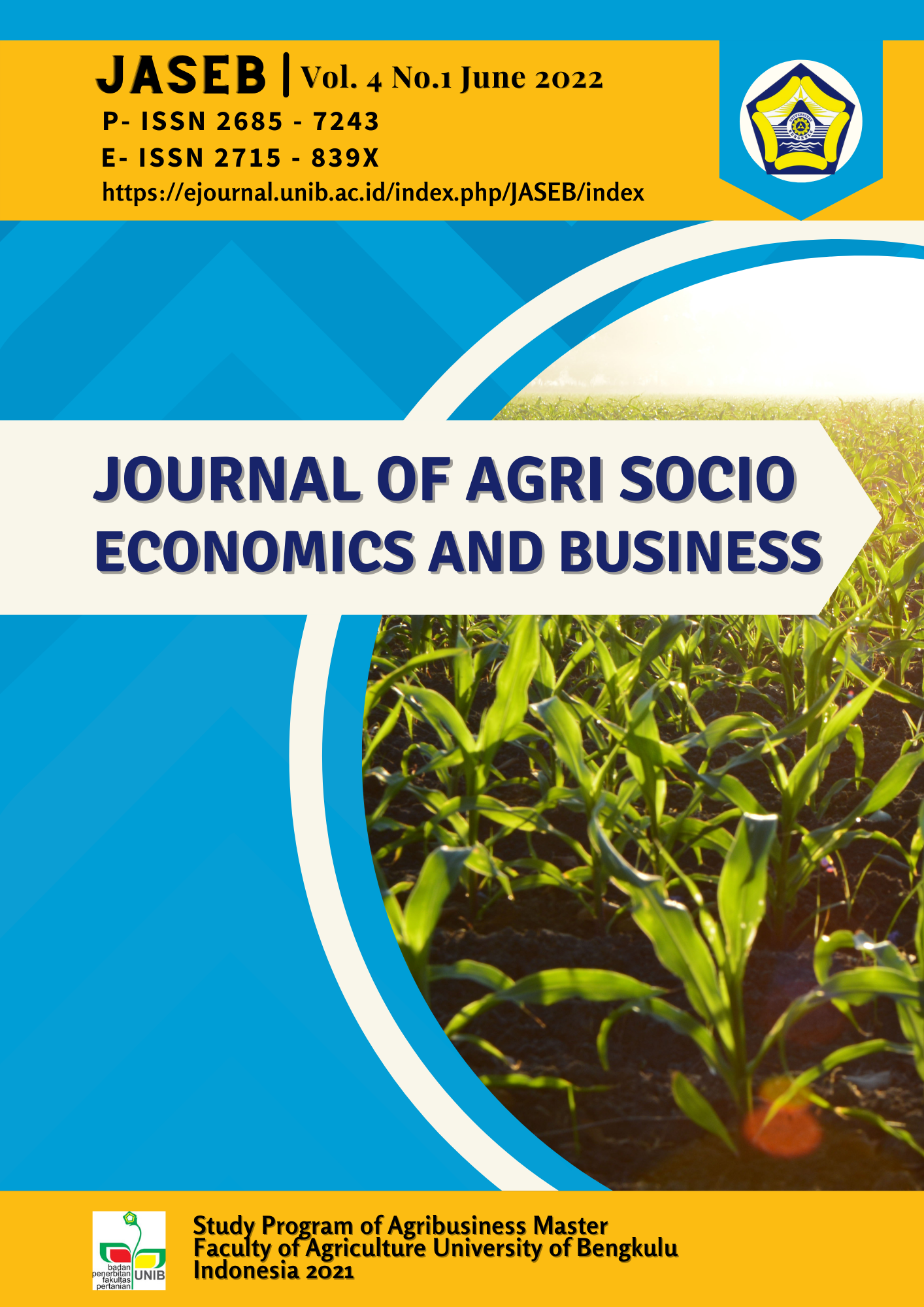Main Article Content
Abstract
This study aimed to determine and analyze the risk of moringa (Moringa oleifera L.) production in rainy and dry seasons at PT Moringa Organic Indonesia, Blora. The research method used is a case study method, using secondary data and time-series data and interviews with the company. The analytical tools used are coefficient variation (CV) and lower limit (L). The results show that the sources of production risk at PT Moringa Organic Indonesia consist of external and internal production risks, external production risks consist of weeds, disease, and seasons, while internal production risks are human resource risks. The calculation result of risk level of Moringa production for rainy season and dry season show the risk level of production in dry season has a high risk because it has a coefficient variation value greater than the rainy season. The lower limit of production (L) was obtained in the dry season, based on the lower limit values of the two seasons, indicating that the losses were lower than dry season during the rainy season.
Keywords
Article Details
An author who publishes in the Journal of Agri Socio Economics and Business agrees to the following terms:
Author retains the copyright and grants the journal the right of first publication of the work simultaneously licensed under the Creative Commons Attribution-ShareAlike 4.0 License that allows others to share the work with an acknowledgement of the work's authorship and initial publication in this journal
Submission of a manuscript implies that the submitted work has not been published before (except as part of a thesis or report, or abstract); that it is not under consideration for publication elsewhere; that its publication has been approved by all co-authors. If and when the manuscript is accepted for publication, the author(s) still hold the copyright and retain publishing rights without restrictions. For the new invention, authors are suggested to manage its patent before published. The license type is CC-BY-SA 4.0.
Journal Agri Socio-Economics and Business is licensed under a Creative Commons Attribution-ShareAlike 4.0 International License.
References
- Krisnadi, A Dudi. 2010. Kelor Super Nutrisi. Blora: Pusat Inforrmasi dan Pengembangan Tanaman Kelor Indonesia.
- Ghani, M.A. 2013. Dampak Perubahan Iklim Terhadap Hasil dan Risiko Produksi di Indonesia. Thesis Program Studi Ilmu Ekonomi. Fakultas Ekonomi. Jakarta: Universitas Indonesia.
- Harwood, J., Richard, H., Coble, K., Perry, J., & Somwaru, A. 1999. Managing Risk In Farming: Concepts, Research, And Analysis. AAb Bs St Tr Ra Ac Ct T. Agricultural Economic Report, 774, 125.
- Hasanah, J., Rondhi, M., & Hapsari, T. D. 2018. Analisis Risiko Produksi Usahatani Padi Organik Di Desa Rowosari Kecamatan Sumberjambe Kabupaten Jember. Jurnal Agribisnis Indonesia, 6(1), 37–48.
- Robison L.J, Barry P.J. 1987. The Competitive Firm’s Response to Risk. London: Macmillan Publisher.
- Roumasset, J. A., Boussard, J. M., Singh, I. 1976. Risk and Uncertainty and Agriculture Development. New York: Agriculture Development Council.
- Satoto, Y. Widyastuti., U.Susanto., dan M. J. Mejaya. 2013. Perbedaan hasil perkebunan antar musim di lahan irigasi. Jakarta: IPTEK Tanaman Pangan 8 (2) : 55-6109. Buku 1. Badan Penelitian dan Pengembangan Pertanian. 7- 31
- Sugiyono. 2016. Metode Penelitian Kuantitatif, Kualitatif dan R&D. Bandung: CV Alfabeta
- Zayed, M.S. 2012. Improvement of growth and nutritional quality of Moringa oleifera using different biofertilizers. Annals of Agricultural Science 57(1): 53-62.
References
Krisnadi, A Dudi. 2010. Kelor Super Nutrisi. Blora: Pusat Inforrmasi dan Pengembangan Tanaman Kelor Indonesia.
Ghani, M.A. 2013. Dampak Perubahan Iklim Terhadap Hasil dan Risiko Produksi di Indonesia. Thesis Program Studi Ilmu Ekonomi. Fakultas Ekonomi. Jakarta: Universitas Indonesia.
Harwood, J., Richard, H., Coble, K., Perry, J., & Somwaru, A. 1999. Managing Risk In Farming: Concepts, Research, And Analysis. AAb Bs St Tr Ra Ac Ct T. Agricultural Economic Report, 774, 125.
Hasanah, J., Rondhi, M., & Hapsari, T. D. 2018. Analisis Risiko Produksi Usahatani Padi Organik Di Desa Rowosari Kecamatan Sumberjambe Kabupaten Jember. Jurnal Agribisnis Indonesia, 6(1), 37–48.
Robison L.J, Barry P.J. 1987. The Competitive Firm’s Response to Risk. London: Macmillan Publisher.
Roumasset, J. A., Boussard, J. M., Singh, I. 1976. Risk and Uncertainty and Agriculture Development. New York: Agriculture Development Council.
Satoto, Y. Widyastuti., U.Susanto., dan M. J. Mejaya. 2013. Perbedaan hasil perkebunan antar musim di lahan irigasi. Jakarta: IPTEK Tanaman Pangan 8 (2) : 55-6109. Buku 1. Badan Penelitian dan Pengembangan Pertanian. 7- 31
Sugiyono. 2016. Metode Penelitian Kuantitatif, Kualitatif dan R&D. Bandung: CV Alfabeta
Zayed, M.S. 2012. Improvement of growth and nutritional quality of Moringa oleifera using different biofertilizers. Annals of Agricultural Science 57(1): 53-62.
